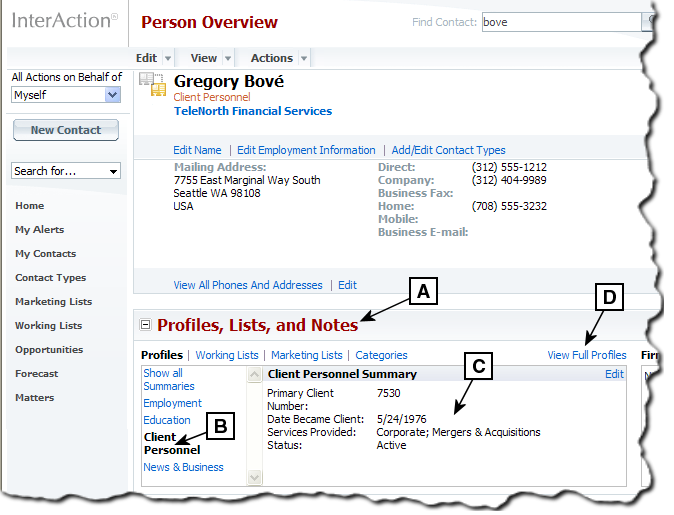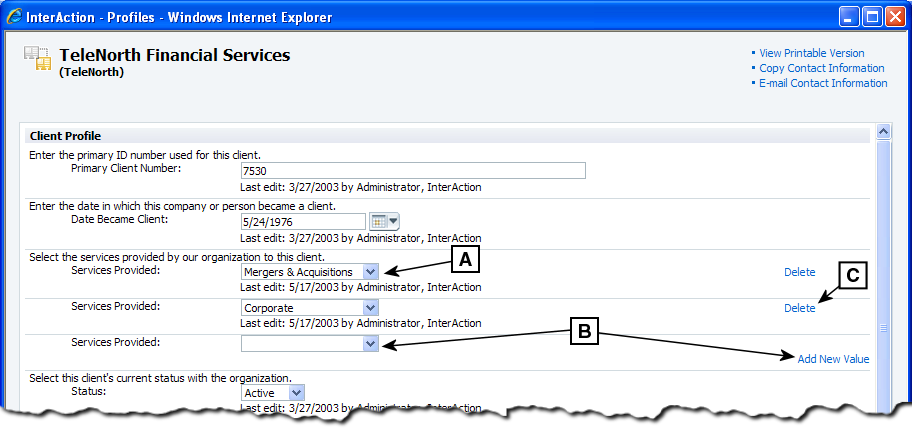Section Topics
Additional Fields for Profiling
Firm contacts can have an unlimited number of additional fields. Additional fields can be used to store any kind of information such as client numbers, the name of a person’s spouse/significant other, educational background or a list of their achievements. Almost any kind of information can be kept for a contact in InterAction using additional fields.
Additional fields can be viewed and edited in the InterAction Web Client. In the Web Client, additional fields are normally used to profile contacts.

Viewing Additional Fields in the Web Client
[A] Expand the Profiles, Lists, and Notes section.
[B] Select the profile to view.
[C] The profile displays in this area. Most profiles display additional fields.
[D] Choose View Full Profile to open a dialog box for viewing and editing all the profile information.
Additional fields can also be used on other folders, such as marketing lists and working lists.
Depending on the access defined by your system administrator, you may be able to edit the values for additional fields shown in profiles. In addition, you can define and manage fields for your own working lists. These are useful for tracking information related to the list. For details about working lists, see Working Lists.
The following sections provide more information about additional fields:
Types of Additional Fields
An additional field can be any one of the following field types:
| Field Type | Description |
|---|---|
| Date | Display a drop-down calendar to collect a date. |
| Decimal | Collect numbers with decimals. You can specify a minimum and maximum value and the number of decimal places. |
| List | Display a drop down list of items you specify. |
| InterAction User | Store InterAction users. When filling in the field, you can look up users by last name. |
| Number | Collect integers (no decimals). You can specify a minimum and maximum value. |
| Text |
Collect any alphanumeric text. You can specify the maximum number of characters allowed (limit is 254). If no limit is specified, the field defaults to 254. You can also specify whether the dialog box that collects the data should use a single-line or multiple-line edit box. This is useful for text fields that need to collect larger amounts of text data. |
| Yes/No | Use option buttons to collect a “true or false” value. By default the labels are Yes and No, but you can specify any labels for the options (for example, “true/false,” “male/female,” “active/inactive,” etc.) |
Storing Multiple Values in Additional Fields
For some additional fields, you may want to store more than one item. For example, the Services Provided field tracks the services your organization provides to a client. Since your organization might provide several different services to the same client, this field is a multiple-value additional field. You can enter as many items as apply.

Entering Data in a Multiple-Value Field
[A] This is the first value entered for this field.
[B] Choose the Add New Value link to add a new “row,” then enter the additional value.
[C] Choose the Delete link to delete a value from the field.
Multiple-value additional fields often use the secondary field to collect additional information about each entry. For example, you could create a multiple-value additional field called “Children” and set the secondary field to “Birthday.” Note that the secondary field can also be used with single-value fields.
In the Web Client, you can define additional fields (including multiple-value fields) for working lists. For details, see Creating and Editing Additional Field Definitions for a Working List.
When defining a multiple value additional field, you can choose to include an additional “secondary” field. This secondary field should be used to collect additional information about an entry.
